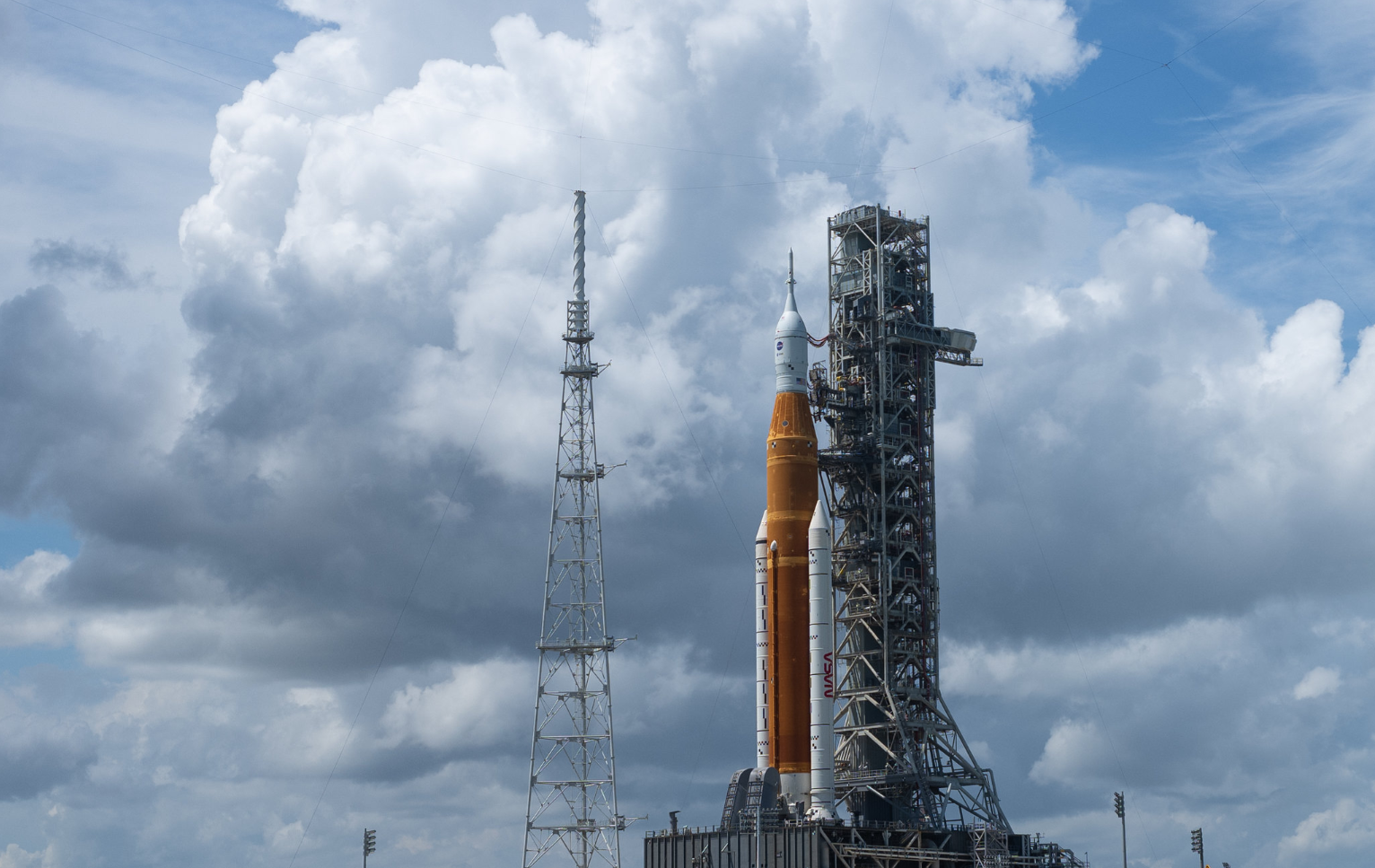NASA Sets Coverage for Artemis I Moon Mission Next Launch Attempt

NASA’s Space Launch System rocket with the Orion spacecraft aboard is seen atop the mobile launcher at Launch Pad 39B, Tuesday, Aug. 30, 2022, at NASA’s Kennedy Space Center in Florida. Credits: NASA/Joel Kowsky
NASA is targeting 1:17 p.m. CDT on Saturday, Sept. 3, for the launch of Artemis I, the first integrated test of NASA’s Space Launch System (SLS) rocket, Orion spacecraft, and the ground systems at the agency’s Kennedy Space Center in Florida. There is a two-hour launch window for the next attempt.
The Artemis I flight test is an uncrewed mission around the Moon that will pave the way for a crewed flight test and future human lunar exploration as part of Artemis.
Live coverage of events will air on NASA Television, the NASA app, and the agency’s website at:
The launch countdown will resume Saturday, Sept. 3, at the opening of a planned 2.5-hour built-in hold, which will begin at 3:37 a.m.
Managers waved off the first launch attempt Aug. 29 when launch controllers were unable to chill down the four RS-25 engines, with one engine showing higher temperatures than the other engines. Teams currently are analyzing data, updating procedures, and checking out hardware to address the issues.
Launch Coverage (all times CDT)
All events will air live on NASA TV, and the information is subject to change based on real-time operations. Follow NASA’s Artemis blog for updates.
Thursday, Sept. 1
5 p.m.: NASA will hold a prelaunch media briefing following a mission management team meeting with the following participants:
- Mike Sarafin, Artemis mission manager, NASA Headquarters
- Charlie Blackwell-Thompson, Artemis launch director, Exploration Ground Systems Program, Kennedy
- John Honeycutt, SLS program manager, NASA’s Marshall Space Flight Center
- Melody Lovin, weather officer, Space Launch Delta 45
Friday, Sept. 2
8 a.m.: NASA will hold a prelaunch media briefing on the status of the countdown with the following participants:
- Jeff Spaulding, Artemis senior NASA test director, NASA Kennedy
- Melody Lovin, weather officer, Space Launch Delta 45
Saturday, Sept. 3
4:45 a.m.: Coverage begins with commentary of tanking operations to load propellant into the SLS rocket.
11:15 a.m.: Full coverage begins in English. Launch coverage will continue through translunar injection and spacecraft separation, setting Orion on its path to the Moon.
Noon: Launch coverage begins in Spanish on NASA’s Spanish-language YouTube account and will continue approximately 15 minutes after liftoff. Mission coverage updates will be posted on the NASA en español social media channels.
5 p.m.: Coverage of the postlaunch news conference will follow approximately one hour after the live launch broadcast ends. Coverage start time is subject to change, based exact liftoff time. The postlaunch news conference will include the following participants:
- Bill Nelson, NASA administrator
- Mike Sarafin, Artemis mission manager, NASA Headquarters
- Mike Bolger, Exploration Ground Systems Program manager, Kennedy
- Howard Hu, Orion Program manager, NASA’s Johnson Space Center
- John Honeycutt, Space Launch System Program manager, Marshall
- Emily Nelson, chief flight director, Johnson
8:45 p.m.: Coverage of Orion’s first outbound trajectory burn on the way to the Moon. Time of coverage start time is subject to change, based on exact liftoff time.
9:15 p.m.: Coverage of first Earth views from Orion during outbound coast to the Moon.
NASA Television coverage of additional events throughout the mission is available online.
NASA Launch Coverage in English
Briefings and launch coverage will be available on the NASA website. Coverage will include live streaming and blog updates. On-demand streaming video and photos of the launch will be available shortly after liftoff.
Follow countdown coverage on NASA’s Artemis blog at:
https://blogs.nasa.gov/artemis
Live NASA TV coverage leading to launch will begin with commentary of tanking operations at 4:45 a.m. Saturday, Sept. 3, followed by launch coverage beginning at 11:15 a.m. Launch coverage will stream on the NASA website, as well as Facebook, Twitch, NASA YouTube, and in 4k on NASA’s UHD channel.
For NASA TV downlink information, schedules, and links to streaming video, visit:
NASA Launch Coverage in Spanish
NASA’s broadcast of the launch in Spanish will include interviews with Hispanic members of the mission and live commentary.
The show, which will begin at noon Saturday, Sept. 3, will be available on NASA en español’s YouTube account, and will continue approximately 15 minutes after liftoff. Mission coverage will then follow on the NASA en español social media channels.
Attend Launch Virtually
Members of the public can register to attend the launch virtually. NASA’s virtual guest program for the mission includes curated launch resources, notifications about related opportunities or changes, and a stamp for the NASA virtual guest passport following a successful launch.
Watch, Engage on Social Media
Stay connected with the mission and let people know you are following the launch on Twitter, Facebook, and Instagram with #Artemis. Follow and tag these accounts:
- Twitter: @NASA, NASAArtemis
- Facebook: NASA, NASAArtemis
- Instagram: NASA, NASAArtemis
Through Artemis missions, NASA will land the first woman and the first person of color on the Moon, paving the way for a long-term lunar exploration and serving as a steppingstone to send astronauts to Mars.
For more information about the Artemis I mission, visit:
https://www.nasa.gov/specials/artemis-i
NASA team members can tap into the VIP Employee Experience here:
https://nasa.sharepoint.com/sites/jsc/SitePages/Artemis.aspx







